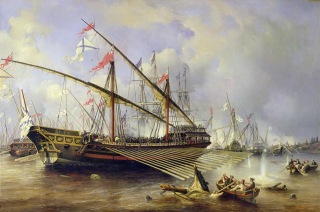Early 18th century Russian Baltic Galley
Galleys, which were supposed to have been eclipsed by the sailing warship in the early seventeenth century, were an important component of the fleets of Sweden and Russia during the eighteenth century.
In the mid-seventeenth century, the main function of the Swedish navy was to protect the lines of communication to the army in Germany. For this it needed a battlefleet to defend the lighter vessels against Danish attack and smaller vessels for inshore work. In the 1680s the main Swedish battlefleet base was developed at Karlskrona to challenge the Danes in the southwest Baltic, away from the shallow waters off the ports of the southeastern Baltic coast. When Russia became a threat in the eastern Baltic after 1703, Sweden was initially unprepared for landing and supply operations within the shallow and convoluted archipelago of the Gulf of Finland and it took a while to expand the galley fleet. The galley and, much later, the gunboat became essential elements in the Russo-Swedish wars of 1741–3 and 1788–90. In both the Levant and Baltic, seapower was essential for the projection of military power to any distance and it rested on the effective combination of forces that could dominate deep water and shallow coastal areas.
The Mediterranean and the Baltic saw large fleets of warships attempting to blockade ports during the period, but the confined and shallow Baltic waters made the interception of coastal traffic very difficult. The first great Russian naval victory over the Swedish fleet, the Battle of Hangö Head on 6 August 1714, was won by a galley fleet making use of the coastal shallows to outmanoeuvre the Swedish sailing fleet.
Russia came from a very different political tradition. Peter the Great’s borrowings from the West are well known, and the great Petrine reorganization of the central administration of the state, 1717–20, owed a great deal to Swedish and German precedent. The central Admiralty College was based on the Swedish model. This might have created problems if Peter had tried to impose an alien culture further down the administrative ladder, but recent research suggests that the Muscovite state was able to create a significant maritime power using more traditional administrative and financial methods. Peter enthusiastically imported galley and shipbuilding technology from Venice, Holland and England, but was wise enough to recognize that the administration of his fleet relied upon traditional noble and merchant relationships. The main problem that Peter faced was that his commitment to the navy was hardly shared by any other interest in the state. Almost as soon as he died in 1725 the fleet began to atrophy.
Jean Meyer has suggested that a major reason for the survival of the galley in the Mediterranean was the absolute dearth of seamen. Soldiers, convicts, slaves or free landsmen could serve at the oars with little or no maritime experience. In the Baltic, Russia found that galleys were useful in the shallow and difficult waters off Finland, and they were also extremely sparing in the use of seamen. Russia only got experience for its seamen very slowly. Some trained under foreign officers in the Russian navy. A very few were sent abroad to serve in the ships of other powers, such as the 30 that Peter I sent to English ships in 1706, but these men were destined to become officers. As late as 1738, it was even suggested that thousands of Russian seamen might serve on British warships if war with Spain should break out in order to gain some experience. It was not until the second half of the eighteenth century that Russia seemed able to train its own seamen for deep-water warfare.
